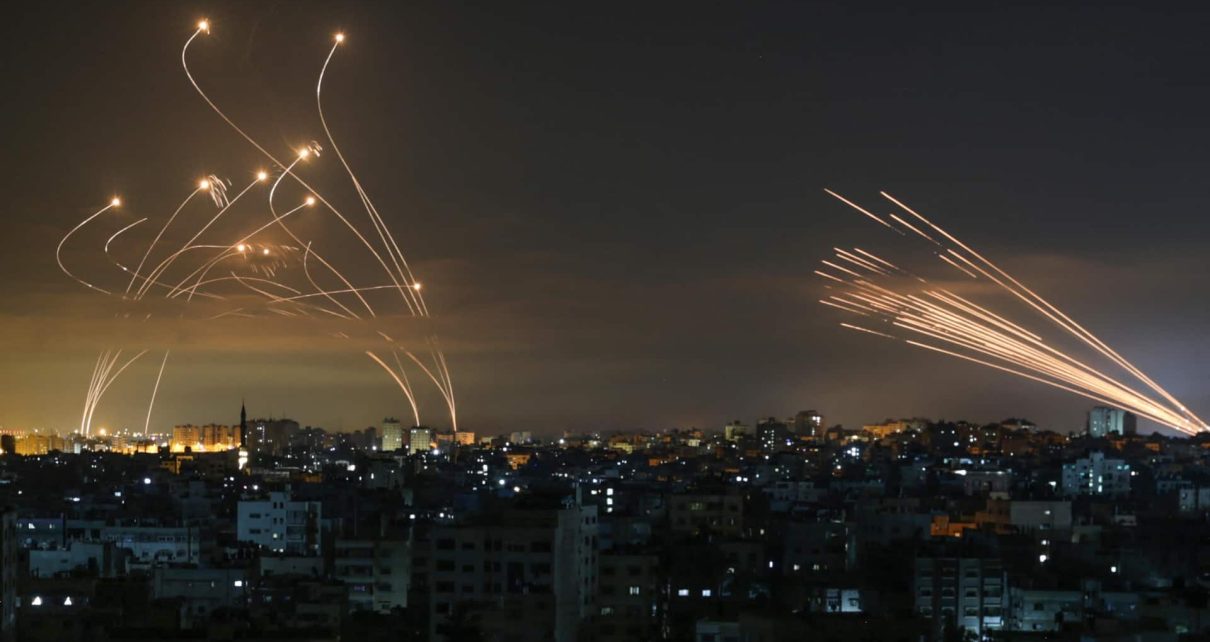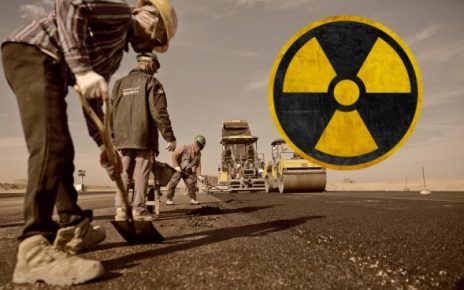On Saturday night, Iran launched what its foreign minister called a “limited” retaliatory strike directly against Israeli military sites. The attack included the launch of a large batch of suicide drones and missiles, managing to inflict damage and triggering a multi-national air defense reaction. Not a single Israeli civilian was killed and the number of combatant casualties is not yet confirmed, yet the G7 and the entirety of Western media are treating the event as if it was an unprovoked terrorist attack.
Iran’s attack on Israeli military sites has prompted a flood of condemnatory remarks from Western politicians, as the mainstream corporate media attempts to frame Israel as the victim of Iranian aggression. While claiming victimhood, the Israelis and their allies also attempt to claim a “success” and that they shot down “99%” of all Iranian munitions fired at them — an allegation that is directly contradicted by video evidence of what appears to be several missile strikes.
At this current point, there are various different narratives being spread across social and mainstream media, all sharing separate interpretations of the events that transpired. Yet, despite the diametrically opposing conclusions drawn on the attack, there are still many details that we do not have access to and the event can still be considered an ongoing incident. Israel, despite reports that the US will not participate in any attack on Iran and urged it not to hit Iranian territory directly, has vowed to respond “when the time is right“. Tehran has warned that any Israeli aggression will result in a much more extensive response than Saturday night’s barrage of missiles and drones. This predicament indicates we may be on the precipice of a back and forth, one which could escalate into a regional war.
What Really Happened
In order to analyze the Iranian retaliatory operation, which it dubbed ‘True Promise‘, we first must establish that Tehran was indeed responding to Israeli aggression. Citing the UN Charter’s Article 51, the Iranians worked hard to prove the absolute legality of their actions. In other words, Israel started this conflict and Iran was retaliating against solely military targets which were involved in the unprovoked Israeli bombardment of their nation’s consulate building in Syria, which resulted in the murder of 7 Iranian officials belonging to its Islamic Revolutionary Guard Corps (IRGC). Israel had also assassinated an IRGC official in late December, then attacked Damascus again in January, killing 5 more Iranians. The January attack committed by the Israeli Air Force did not trigger any Iranian response.
On April 1, following the unprecedented Israeli attack on Iran’s consulate, constituting a direct attack on Iranian soil, the issue triggered Russia to request an urgent meeting at the United Nations Security Council (UNSC), where the US government would prevent any statement condemning the illegal strike from passing. Iran attempted to appeal to the International Community and expressed its intent to take legal action against Tel Aviv, but to no avail, leaving them with the only other option; to launch a retaliatory military operation, which they vowed to do.
For almost 2 weeks the Iranians openly announced they would carry out a retaliatory strike against Israel, playing mind games with their enemy by releasing plenty of intelligence chatter that created speculation over when and how the operation would take place. Iran then, 72 hours prior to the attack, informed the United States, as well as a number of regional nations, of their intention to launch strikes against Israel. Despite Turkiye, Iraq, and Jordan all affirming that Tehran gave a wide warning prior to its attack, Washington has attempted to deny this in order to argue that Iran sought to inflict greater damage than it did. These public and private warnings, which were clearly spread far and wide, led to announcements from several nations that their citizens should imminently depart from Israeli territory and announced the grounding of flights across Palestine-Israel, Jordan, Iraq, Lebanon, and Iran, a few hours prior to the beginning of Iran’s military operation.
Although Iran’s retaliatory strikes were on a much larger scale than had been anticipated by anyone, including the launch of around 300 munitions, it was clearly an operation that sought to prevent an all out war with Israel and instead to achieve the goal of strategic deterrence. Iran launched waves of older model loitering munitions, in order to distract the Israel, US, UK, and Jordanian air-defense effort, while also launching a batch of older model cruise missiles and ballistic missiles, then sending through around a dozen advanced ballistic missiles that specifically targeted Israeli military facilities. Three military sites were said to have been struck, while two primary targets that were involved directly in the Iranian consulate strike, were hit. These two military bases were the Nevatim Airbase in the Naqab (Negev) area, in addition to the Mount Heron base in the illegally occupied Golan Heights.
Israel’s military censor, which effectively hides and even produces fabricated information to misinform the public, has alleged that minor damage was caused to the Nevatim base from which its F-35 fighter jets allegedly attacked Iran’s consulate building. Videos showed multiple missile strikes on the base, while satellite photos have allegedly revealed damage to one of the base’s runways, which Israel denies. Israel confirmed casualties, but refused to give any specific details and has not announced any deaths. As for the direct strikes on Mount Heron base, the military censor has prevented the release of any information about the extent of the damage or number of casualties. The Iranian military has claimed that the operation was a bigger success than they had expected, but that it was awaiting confirmation on a number of the details. From what we have access to at this time, we can confidently say military sites were struck with ballistic missiles, yet it is not possible to tell how major the destruction was.
Then we have the more important aspects of the strikes: what it achieved and what it was designed to do. While some will look at the lack of videos showing the destruction caused by the missile strikes that we know occurred, labelling the entire event theater and claiming it was a weak retaliation — this analysis is either emotional or lacks critical analysis. The reason why this framing doesn’t work is two fold: Firstly, our information is incomplete on the extent of the damage, and, as was the case when Iran struck US forces at Iraq’s Ain al-Assad base in 2020, it took a month before the US army admitted that over 100 injuries had occurred and significant damage was inflicted. When that retaliatory strike occurred in 2020, following the assassination of Iranian General Qassem Soleimani, then US President, Donald Trump, announced that there were no injuries or deaths and that his forces had successfully shot down most of the missiles fired, arguing that Iran had backed down. The second reason it makes little sense to argue this, is because Iran only targeted military bases and did not fire munitions at population centers or civilian infrastructure (despite numerous high level figures repeatedly claiming otherwise with zero evidence) as we have all seen Israel continue to do in Gaza. This was openly declared to be a targeted operation that was meant to achieve deterrence and serves as a slap, not a knockout blow that aims to level Israeli cities indiscriminately.
Others have alleged that Israel pulled off a victory by shooting down the majority of incoming missiles, this narrative is quite laughable and easily proven to be false. First, everyone knew Iran was launching the attack days in advance, and an hour prior to the launch of the first batch of drones, the airspace above Iraq, Jordan, and Palestine-Israel was completely closed. This means that the only targets in the sky were Iranian munitions that were traveling at a slow speed and hence easier to track. The purposefully slow drones took hours to reach Israeli airspace and had to pass through US air defense systems located in Iraq and Jordan, before reaching Israeli territory, all of which were on high alert while waiting for Iranian munitions. In addition to this, US, UK, Jordanian, and Israeli aircraft were all in the sky working together to confront the incoming missiles and drones, having hours to confront their targets. Iran fired the majority of its drones and missiles, which were cheaply produced older munitions, with the sole purpose of providing cover for a few batches of their advanced ballistic missiles that were the only projectiles to reach their targets.
If anything, the attack proved that without the support of the US and a huge advantage of being informed of the exact nature of the strike, Israel is helpless and incapable of defending itself from an Iranian attack. This is, in and of itself, the biggest blow that Iran delivered to the Israelis — it sent the message that they can hit them even under the most difficult of circumstances. On top of this, many of the munitions that did end up reaching Israeli airspace created a huge amount of chaos and fear amongst the Israeli public, resulting in embarrassing videos of Israelis running and screaming in fear, in addition to the full view of missiles in the sky that was visible from every area throughout occupied Palestine. The multi-national air defense mission to protect Israel, lasting around 5 hours in total, was said to cost over 550 million dollars and didn’t even prevent the military location objectives that Iran targeted from being hit.
How successful this retaliatory operation will be depends upon what happens next. It is expected that the Israelis will launch some sort of illegal military action against Iran or one of its allies, which could then trigger a back and forth between both sides. Following this is when definitive statements can be made as to what exactly the Iranian attack has achieved or not achieved. At this time, we can assess that the operation was a lot larger than had been expected, that Iran hit military targets, and demonstrated it can deal a blow to the Israelis, if they choose to. It also has to be noted that despite the fact that a small batch of drones were launched from Yemen, along with some missiles from Iraq and a barrage of rockets from Lebanon, prior to when the Iranian projectiles approached Israeli airspace, the contribution of Iran’s regional allies to this attack was extremely minimal and didn’t work to provide effective cover for Iran’s attack, as had been anticipated by some. The operation also was not a declaration of war and was instead a statement.






not only was it calculated it was green lit by the biden administration https://www.reuters.com/world/middle-east/iran-informed-turkey-advance-its-operation-against-israel-turkish-source-2024-04-14/